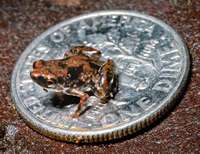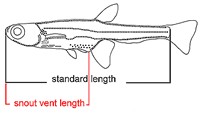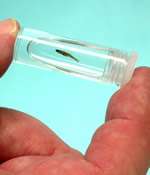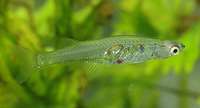The battle to identify the world's smallest vertebrate

More and more really tiny species are being discovered, like a 7.9mm fish in 2006 and a 7.7mm frog in 2011. There's increasing competition for the title of the 'world's smallest vertebrate', but exactly how do you determine what is the smallest?
Natural History Museum fish expert (ichthyologist) Dr Ralf Britz helped analyse the world's smallest fish, and vertebrate (back-boned animal), in 2006. Paedocypris progenetica is 7.9mm long and lives in the acidic swamps of Sumatra. He explains what's involved in determining the smallest creatures.
Find an adult
The first step is to find an adult of the species. 'You need to establish that you are dealing with a mature individual,' says Ralf. 'This means you have to confirm that its gonads are fully developed.'
'In fish, this is more easily done in females because you can check if the eggs in the ovaries are ripe.' Adult females will have bulging ovaries with relatively large eggs.
Establishing the maturity of gonads in males is harder and requires making microscopic sections, says Ralf.
Measuring tiny fish
Once you have established you have an adult, you need to measure the specimen. 'We measure fish from the tip of the snout to the end of the body, at the point where the caudal fin rays [tail fin] attach,' says Ralf.
This is called the standard length and is used by fish researchers. 'The reason we use the standard length rather than measure to the end of the fin is because the tips of caudal fin rays are frequently damaged or broken off, and so would give an incorrect measurement.'

Measuring other animals
Other animals are measured in different ways. For example, in frogs researchers measure the distance between the snout and the vent (anus) known as the snout-vent length.
Measuring fish the same way would result in much shorter lengths, explains Ralf. 'For example the snout-vent length of the fish Paedocypris progenetica would be just 4.3mm and therefore much smaller than the frog Paedophryne amauensis, the species that is considered by some to be the smallest vertebrate!'

Comparisons with other smallest specimens
Once you have determined its size, you need to compare the specimen with others, such as those in the Museum's world-class collection.

'The smallest fish and vertebrate specimens we have in the Museum collection are species Paedocypris micromegethes (which grow up to 11.4mm), P. carbunculus (up to 11.5mm), and also Danionella translucida (up to 12mm),' says Ralf.
Close to the limit?
So, are we close to the smallest size that exists in nature? Ralf thinks so. 'Among vertebrates, I think we are getting very close to the lower size limit with the recent discoveries of tiny fishes, frogs, and reptiles.
'The same is true for insects. Regarding the other invertebrate groups there may be still a number of smaller species waiting to be discovered.'
Hazards to being tiny
One of the biggest drawbacks of being tiny is that you become prey to more predators, says Ralf. 'While larger fish do not have to fear many invertebrate predators, a tiny fish like Danionella or Paedocypris could be easily eaten by aquatic beetles or dragonfly larvae.'
Another problem for tiny creatures, suggests Ralf, is likely to be the number of offspring. Because egg size has a lower limit too, small animals produce less of them. So each individual produces fewer offspring, risky when your small size means you are already easy prey.

Why evolve so small?
Many tiny animals seem to evolve in unusual habitats. Britz explains, 'There seems to be some correlation between special habitats and small size. Some of the smallest invertebrates live among grains of sand, are parasitic or, in the case of P progenetica, live in extremely acidic water.'
'In the end becoming very small is just another way of adapting to the environment, as is being very big or being of regular size.'
With such a diversity of habitats on our planet, many of them unexplored, it's likely that there'll be more 'smallest' species discoveries to come.
So, just what is the smallest vertebrate? Ralf concludes, 'Applying the same way of measuring frogs to Paedocypris - that is, using the same landmarks - clearly demonstrates that the fish P. progenetica is still the smallest vertebrate!'
More information: Read about the research in the Dracula minnow has teeth, almost news.
World's smallest vertebrate paper in PLoS One Jan 2012.
Provided by Natural History Museum





















